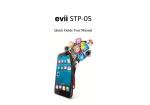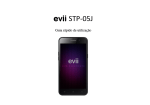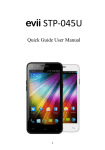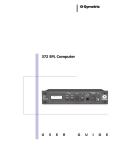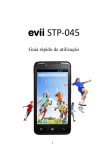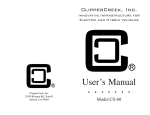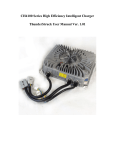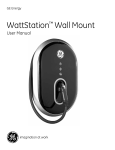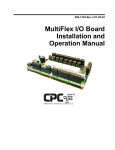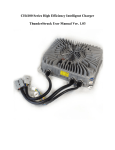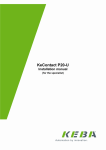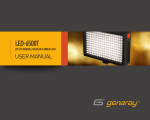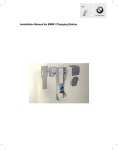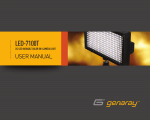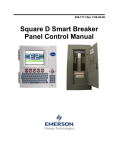Download User`s Manual - EV Charger News
Transcript
User’s Manual • • • • • • • ® ELECTRIC VEHICLE INFRASTRUCTURE, INC. 11839 INDUSTRIAL COURT ~ AUBURN, CA 95603 PLEASE NOTE This user’s manual includes the latest information at the time of printing. Electric Vehicle Infrastructure, Inc. (EVI) reserves the right to make changes to this product without further notice. Changes or modifications to this product by other than an authorized service facility could void the product warranty. If you have questions about the use of this product, contact your customer service representative. Refer to the Customer Support section located in this guide. DS-50 User’s Manual, PDF Version 2.1, December 2000 Copyright © 2000. Electric Vehicle Infrastructure, Inc. All rights reserved. Printed in the USA. DS-50 User’s Manual CONTENTS IMPORTANT SAFETY INSTRUCTIONS Safety Guidelines . . . . . . . . . . . . . . . . . . . . . . . . . . . . . . . . . 1 OPERATION Front Panel . . . . . . . . . . . . . . . . . . . . . . . . . .. . . . . . . . . . . . In Case of Difficulty. . . . . . . . . . . . . . . . . . . . . . . . . . . . . . . 3 4 FEATURES Personal Protection System . . . . . . . . . . . . . . . . . . . . . . . Auto-Reclosure . . . . . . . . . . . . . . . . . . . . . . . . . . . . . . . Off-Peak Charging . . . . . . . . . . . . . . . . . . . . . . . . . . . . . Power Outage Restore . . . . . . . . . . . . . . . . . . . . . . . . . . . External Error Indicator . . . . . . . . . . . . . . . . . . . . . . . . . . . . Maintenance Current . . . . . . . . . . . . . . . . . . . . . . . . . . . . . . 5 5 5 5 6 6 INSTALLATION Service Connections . . . . . . . . . . . . . . . . . . . . . . . . . . . . . . . Mounting Procedures . . . . . . . . . . . . . . . . . . . . . . . . . . . . . . Wiring . . . . . . . . . . . . . . . . . . . . . . . . . . . . . . . . . . . . . . . . . . Testing After Installation. . . . . . . . . . . . . . . . . . . . . . . . . . . . 7 10 11 12 FOR THE SERVICE TECHNICIAN . . . . . . . . . . . . . . . . . . 13 SPECIFICATIONS . . . . . . . . . . . . . . . . . . . . . . . . . . . . . . . . . 15 WARRANTY INFORMATION . . . . . . . . . . . . . . . . . . . . 16 FCC INFORMATION . . . . . . . . . . . . . . . . . . . . . . . . . . . . . . 16 CUSTOMER SUPPORT . . . . . . . . . . . . . . . . . . . . . . . . . . . 17 MAINTENANCE . . . . . . . . . . . . . . . . . . . . . . . . . . . . . . . . . . 18 DS-50 User’s Manual IMPORTANT SAFETY INSTRUCTIONS Carefully read these instructions and the charging instructions in your vehicle owner’s handbook before charging your electric vehicle. The following symbols may be found in your handbook or on labels affixed to your conductive charge station: Note This means pay particular attention. Notes contain helpful suggestions. Caution This symbol means be careful. You are capable of doing something that might result in damage to equipment. Warning This symbol means danger. You are in a situation that could cause bodily injury. Before you work on any electrical equipment, be aware of the hazards involved with electrical circuitry and standard practices for preventing accidents. Safety Guidelines • Use this charge station to charge electric vehicles equipped with a conductive charge port only. See the vehicle’s owner’s handbook to determine if the vehicle is equipped with a conductive charge port. • Make certain the charge station’s supply cable is positioned so it will not be stepped on, tripped over, or otherwise subjected to damage or stress. • There are no user serviceable parts inside. Refer to the Customer Support section in this manual for service information. Do not attempt to repair or service the charge station yourself. • Do not operate your charge station with a visibly damaged supply cable or charge station. Contact your Service Representative for service immediately. Refer to the Customer Support section in this manual for information on the Service Representative in your area. Page 1 DS-50 User’s Manual Warning: Turn off input power to your charge station at the circuit breaker panel before servicing or cleaning the unit. · Note VENTILATION: Some electric vehicles require an external ventilation system to prevent the accumulation of hazardous or explosive gases when charging indoors. Check the vehicle’s owner’s handbook to determine if your vehicle requires ventilation during indoor charging. Those vehicles which follow the SAE J1772 standard for communication with the charging station can inform the DS-50 that they require an exhaust fan. The DS-50 is not equipped to control ventilation fans. If an exhaust fan is requested, the DS-50 will not charge the vehicle. If this function is required, ask your EVI representative for information on the EVI® ICS-200B, which has the exhaust fan control feature. Caution: DO NOT charge your vehicle indoors if it requires ventilation. Contact your Service Representative for information. Page 2 DS-50 User’s Manual OPERATION The DS-50 Electric Vehicle Charging Station is a conductive charge station that provides the electric vehicle (EV) user with a safe and manageable link between the power grid and the EV. Figure 1. The DS-50 Charging Station The DS-50 Electric Vehicle Charging Station is very easy to use. Just remove the charging connector from its holder on the front of the charging station, and plug it into the vehicle’s charge port. Upon insertion, push down on the handle to lock it into place. Normally, the vehicle will immediately request a charge using a special communication line in the cable, and the contactor inside the DS-50 can be heard closing. The green Charging light will come on, and charging will begin. After an average driving day, it will require several hours to recharge completely. Charging overnight is the most convenient way to maintain healthy batteries and ensure the vehicle’s full range will be available for the next day. To remove the connector from the vehicle, depress the button in the middle of the handle to release the connector. When not in use, store the connector in the DS-50’s front panel holder. Front Panel The front panel has a GREEN and a RED light to indicate the status of the DS50. The operational state of the unit can be known just by looking at the two lights, and comparing them with table 1 on page 4. Page 3 Table 1. Front Panel Indicators (Gre e n) (Re d) CHARGING PROTECTION -- -- not connected, or vehicle not requesting charge lit -- charging -- lit ground fault tripped, or service required lit lit problem on vehicle blink -- charge disabled, or Power Outage Restore mode STATUS of DS-50 Note: in the table above, a (--) symbol indicates the LED is off. In Case of Difficulty EVI recognizes that this Charging Station will be heavily relied upon to charge your electric vehicle for daily transportation needs. Therefore, every effort will be made to restore service should problems arise. In the event of a problem, charging will stop and the red Protection light will come on. If this happens, please try the two simple steps below before calling your Field Service Representative. 1. Remove the cable connector from the vehicle socket. The red Protection light may go out. If it does go out, plug the connector back into the socket, and see if charging begins normally. If it doesn’t charge, call for Field Service. 2. If the red Protection light does not go out when the connector is removed, be sure the connector is removed from the vehicle socket and switch off power at the circuit breaker feeding power to the DS-50. Wait a few seconds and switch the circuit breaker back on again. If the Protection light does not come back on, re-connect the cable to the vehicle. Charging should begin normally. If charging does not begin, call for Field Service. The information gained by the above steps will help the Field Service Representative decide what the problem is, and how best to get your DS-50 operational again as quickly as possible. Page 4 DS-50 User’s Manual FEATURES The following features are supported by the DS-50: Personal Protection System: Ground Fault protection with Self-Testing and Auto-Reclosure (see below), no manual resetting or testing is necessary. Ground Monitoring Circuit: Constantly checking for the presence of a Safety Ground connection. Auto-Reclosure: If a problem occurs that interrupts charging, the unit will automatically clear all error indications after 5 minutes, and attempt to begin charging again. If the problem is immediately sensed a second time, it will wait another 5 minutes and try again. This process will repeat several times, at which point power will be removed and no further attempt will be made. The red front panel Protection LED will be lit. This feature helps ensure that your vehicle will be charged and ready for use when needed. Temporary problem indications such as ground-faults or utility power surges can be overcome automatically without the need for the user to manually re-initiate charging. Off-Peak Charging : for this feature, you must have an external timer installed (purchased separately), and also have your local utility install a special Time of Use meter. Many utilities plan to give very low rates to those EV owners who charge in the late evening. If a timer is installed, you do not have to wait until the late evening to plug the DS-50’s connector into the vehicle. You may plug in at any time. Even though the vehicle may immediately request a charge, the timer will cause the DS-50 to delay energizing the cable until the off-peak hours when most electric utilities have light demand. With this feature, the green Charging light will be flashing while the vehicle is waiting for the timer to allow charging. If this feature is desired, please call your local utility to be sure the Time of Use meter is available in your area before having the timer installed. Technical information to help the installer connect the timer to the DS-50 can be found in the section titled Specifications on page 15 in this manual. Power Outage Restore: This feature is built-in to the DS-50, but will only be apparent when the utility power fails during charging. If the charging connector is still plugged into the vehicle when utility power is restored, the unit will blink the green Charging light and not energize the cable for a random time between 2 and 12 minutes. This is to prevent the utility’s grid from experiencing a large surge at turn-on, allowing EV’s in the area to begin drawing current at random times rather than all at once. Page 5 DS-50 User’s Manual The user does not need to be concerned that the vehicle needs attention after a power outage. The DS-50 will automatically resume charging when power is restored. External Error Indication: Whenever the red Protection LED is lit, a relay on the board will provide a contact closure that can be used to remotely indicate that a problem exists. A fleet vehicle yard, for example, could use this feature to light a lamp or ring a bell in the main office, letting them know immediately that a vehicle is not charging. This early warning helps assure that each vehicle will be properly charged and ready for use when needed. Maintenance Current: If the unit is set up for Off-Peak Charging as described above, no current can be drawn by the vehicle until the Off-Peak hours. However, the DS-50 can also be set up to allow a minimum amount of current while waiting for the timer to allow full-rate charging. This is known as Maintenance Current, used for all power needs on the vehicle except charging the main battery pack. An example would be preheating the cab, or keeping the auxiliary battery topped off. As in the Off-Peak mode above, the green Charging light will flash if the vehicle is connected and waiting for the timer to allow charging. The contactor will close immediately to supply this small amount of power, but the main battery pack will not be allowed to charge. The Maintenance Current feature can be enabled and disabled using a jumper on the PC board labeled CMELD. This is a 2-pin jumper located to the right of the Charge Test buttons. The DS-50 is shipped from the factory with Maintenance Current enabled, with the jumper in place. To take advantage of the feature will require the following: 1. Installation of a Time-Of-Use meter by the electric utility. 2. Installation of a clock/timer to only allow the DS-50 to charge during the Off-Peak hours. Please refer to Service Bulletin number 200001001 on EVI’s website @ www.evii.com for additional information on the Maintenance Current feature. From our Homepage, just click on the Download Area and scroll down to Service Bulletins. Page 6 DS-50 User’s Manual INSTALLATION Service Connections Caution This is a single-phase device. Do not connect all 3 phases of a 3-phase feed !!! You may use any two phases of a 3phase wye-connected feed. The center-point of the 3 phases (usually used as Neutral) must be grounded somewhere in the system. A current-carrying Neutral is not needed by the DS-50. Only Line 1, Line 2, and Ground are required. Caution The two phases used must each measure 120V to Neutral. Earth Ground must be connected to Neutral at only one point, usually at the Service Entry Breaker Panel. Caution If a 208V 3-phase feed is from a Delta-connected secondary, the leg used must have a center-tap. That tap must be Grounded. Only the two phases either side of the center-tapped leg can be used. See Fig. 4 below. Caution Warranty is void if this unit is wired improperly Warning Only a qualified electrician should perform the installation. The installation must be performed in accordance with all local electrical codes and ordinances. Only 3 wires are connected, but care must be taken that the service transformer secondary connection is definitely known, and the 3 wires from the main circuit breaker panel are connected and labeled correctly. Figures 2, 3, and 4 below show the most common service transformer secondary wiring formats. Notice that L1, L2, & Gnd are labeled on each diagram. Those transformer outputs correspond to the same inputs on the DS-50. Also, each of the two 3phase diagrams shows an L3 output, which is not used. Do not connect all three phases of a 3-phase secondary to the DS-50. This is a single-phase device. The Neutral at the service panel must be connected to earth ground somewhere in the system on any of the three connection arrangements. Ground-fault protection is not possible unless the Neutral (center-tap on the service transformer) is connected to an earth ground. If no ground is provided by the electrical service, a grounding stake must be driven into the ground nearby, following local electrical codes. The grounding stake must be connected to the ground bar in the main breaker panel, and Neutral connected to ground at that point. Page 7 DS-50 User’s Manual Warning Local electrical codes must always be followed when installing the grounding stake. The following diagrams illustrate the 3 service transformer secondary connections most common in the United States. Figure 2. 220/240V Single Phase L1 120V NEUTRAL (NOT USED) 240V 120V L2 GND Figure 3. 208V 3-Phase, Wye-Connected L3 (NOT USED) L1 120V 208V NEUTRAL (NOT USED) 120V L2 GND Page 8 DS-50 User’s Manual Note With a wye-connected secondary, any two of the legs can be used to provide 208V to the DS-50. For example, L1 & L2, or L1 & L3, or L2 & L3. Leave the unused leg open. Do not connect it to a Neutral bar, or to Ground. Be sure the center point is grounded to earth somewhere in the system. Figure 4. 208V 3-Phase, Delta-Connected, with center-tap on one leg. L3 (NOT USED) L1 120V 208V NEUTRAL (NOT USED) 120V L2 GND Caution With the delta connection, one leg must be centertapped, and only the two phases on either side of the center tap can be used. The two phases must both measure 120V to neutral. The third line (L3) of the delta is 177V, with respect to neutral, and is sometimes referred to as a “stinger”. Do not use this third line! Also, when using the center-tapped leg in this fashion, the power rating for that leg alone is much less than the power rating of the entire transformer. Consult the transformer manufacturer’s literature to be sure the single leg can supply the required current. Caution A 3-phase delta-connected transformer secondary without a center-tap on one leg is not usable with the DS-50. No “neutral” point is available to be connected to ground for groundfault protection, and the DS-50 will not allow the contactor to close if it does not sense the presence of a ground wire connected to a “neutral” point on the transformer secondary. Page 9 DS-50 User’s Manual Mounting Procedures Before installation, remove the screw at the bottom of the front panel, turn the front panel upside down, and re-insert the screw to hold the panel out of the way. This provides support to the LED wires going from the front panel to the PC Board. They can also be disconnected and the panel completely removed if desired, but the three connections must be carefully noted to be sure they are reinstalled correctly later. Be sure not to pinch the wires between the panel and the bottom lip of the enclosure base. Fig. 5 below illustrates the procedure. Fig. 5. Removing, turning, and re-attaching the front panel during installation. AFTER BEFORE Charging Protection PANEL LED WIRES PC BOARD Remove Screw Here Protection Charging • Be sure there is solid structural support for the unit – do not rely on sheetrock or other non-structural support. • Use the drill template provided – do not use the box as its own template. Do not drill through the box mounting holes into the wall. Keep the interior of the box as free of debris as possible. • Do not punch rear or top-entry holes in the enclosure to bring in service wiring. Page 10 DS-50 User’s Manual The DS-50 is not intended for this type of installation, and component spacings inside the unit will not allow wiring in this manner without violating UL requirements. Use the bottom-left knockout with the proper conduit from the circuit breaker panel. • Locate the bottom of the enclosure 38 inches above ground. Also, the unit should be placed to allow the 22-foot charging cable to easily reach and connect to the vehicle’s charging port. • Use the ¼” water-sealing compression washers provided under the 4 bolt heads to seal the rear of the enclosure against water entry. Wiring Before connecting wires to DS-50, please carefully read the section of this manual titled Service Connections, on page 7. If you are unsure of the type of power provided at the service panel, please consult with your local utility or call your Field Service Representative for assistance. Figure 6. DS-50 Service Wiring Brown Black L1 RED L1 Contactor PWR OUT PWR IN L2 L2 BLACK Black Brown Be sure RED and BLACK wires both go through the CCID sense coil PC BOARD LEDS CCID Sense Coil CHARGE TEST Blue Pilot GND GND Blue GREEN Gnd Terminals Violet Yellow x 2 Charge Disable (Ground to Disable Charging) External Error Relay Contacts Cable to Vehicle From Service Panel Page 11 DS-50 User’s Manual Caution: When replacing the vehicle charging cable, be sure the RED and BLACK wires both go through the CCID sense coil. Refer to Fig. 6 on page 11. • The DS-50 requires a dedicated 208/240 VAC 50/60 Hz, single phase circuit, with its own circuit breaker. Refer to the Current chart on page 15 to determine circuit breaker size. • Do not use a GFCI breaker with the DS-50. It contains a Personnel Protection ciruit that is the equivalent and specifically designed for use with electric vehicles. • Only 3 wires are needed to wire the DS-50 (Line 1, Line 2, and Service Ground), as shown in Fig 8 above. Wire the unit from the breaker panel using wire sized according to local electrical codes. • The two phases (Line 1 & Line 2) are terminated in the large wiring lugs right on the contactor. The Service Ground is terminated in the Ground Terminal at the bottom of the enclosure. • Be careful not to damage the PC Board when removing the power-entry knockout, attaching the conduit, or when wiring the service conductors to the contactor. • The 2-pin jumper on the PC board labeled CMELD is used to enable/ disable the Maintenance Current. If jumpered, Maintenance Current is enabled. Generally, for most users, Maintenance Current should be left enabled, with the jumper installed. Testing After Installation • Apply utility power, and observe that only the Diagnostic LED is flashing on the circuit board, at a ½ sec rate. If it is not flashing, the board could be defective. • Push both of the Charge Test buttons at the same time. The contactor should close, and the green Charge LED on the front panel should light. The Charge Test buttons simulate connection to a vehicle. • If a vehicle is available, connect the DS-50 to the vehicle and verify that the contactor closes and the Charging LED comes on. • Remove the front cover screw, turn the front cover around and install it normally to close up the DS-50. Be sure not to pinch the small wires between the cover and the enclosure. Installation is complete. Page 12 DS-50 User’s Manual FOR THE SERVICE TECHNICIAN There are 6 LEDs on the PC board to help diagnose problems: Diagnostic – this is the “heartbeat” of the system. When only this LED is slowly flashing, the system has not detected any failures. If it is lit but not flashing, the board is defective. If it is not lit, either no power is applied or the board is defective. To test the system, press and hold both Charge Test buttons simultaneously. If the contactor closes, the DS-50 is operating normally. If a vehicle is available, connect the charging cable. The contactor should close. If not, the charging cable or vehicle socket may be defective, or the vehicle is not requesting a charge. If the DS-50 detects an internal failure, the Diagnostic LED will blink at a faster rate. One of the other LEDs may indicate the nature of the problem. Charge: Lit, and not flashing, when the contactor is closed and the vehicle is charging normally. It will be flashing when the vehicle is connected while the DS-50 is in either of two modes: • Power Outage Restore mode, after a power outage, waiting for a random 2-12 minute interval to pass before re-initiating charging. • External Timer mode, waiting for the timer to indicate an Off-Peak Charging time is available. Charge Disable: Lit when either the Power Outage Restore or External Timer mode mentioned above is active. Both the board and front panel Charge LEDs will be blinking. GFCI Trip: Lit when the unit has detected a ground fault. The contactor will open, the front panel Protection light will also be lit, and the Diagnostic LED will be flashing at a faster rate. The system waits 5 minutes after sensing a fault, then automatically attempts recovery. After several such attempts, it will stay in the Protection mode. If a ground fault error or an EV connection error has been detected: 1. Remove the EV connector from the vehicle 2. Inspect the connector and the vehicle’s charge port. Be sure they are clean and undamaged. 3. Reconnect to the vehicle. If the fault condition persists, a problem may exist on the vehicle. Page 13 DS-50 User’s Manual 3. Refer to the vehicle owner’s manual for instructions on inspecting and cleaning the charge port. 4. Plug the EV connector back into the vehicle. 5. If the ground fault error is still detected, contact your customer service representative for assistance. Ground Missing: Lit when the unit has detected a missing Service Ground. The DS-50 will not close the contactor unless a proper Service Ground is connected. The front panel Protection light will also be lit, and the Diagnostic LED will be flashing at the faster rate. NOTE: If a missing ground is discovered, power must be turned off before re-connecting the ground. If this is not done, it will be necessary to wait 5 minutes for the DS-50 to clear the Ground Missing error. Service: Lit when the DS-50 detects a failure in either itself or the vehicle. To troubleshoot, be sure the charging cable is disconnected from the vehicle, and reset the DS-50 by turning the power off and back on at the breaker panel feeding the DS-50. If the Service LED remains lit, the DS-50’s PC board has a problem, and should be replaced to restore service as soon as possible. Table 2 below illustrates the information that can be obtained from the 6 LEDs. Note: a (--) symbol indicates the LED is off. Table 2. PC Board Diagnostic LEDs LED 1 Status LED 2 LED 3 LED 4 LED 5 LED 6 Diagnostic Charge Blink Rate CCID Trip Ground Charge Service Missing Disable Required Normal Operation slow -- -- -- -- -- Charging s l ow lit -- -- -- -- Charge Disabled slow blink -- -- lit -- Cold Load Pickup slow blink -- -- lit -- CCID Trip fast -- lit -- -- -- Vehicle Error fast lit -- -- -- lit Ventilation Requested fast lit -- -- -- lit Ground Missing fast -- -- lit -- -- Unit or Vehicle Service fast -- -- -- -- lit Page 14 DS-50 User’s Manual SPECIFICATIONS Input Power - Service Entrance Voltage & Wiring 240V AC single-phase -L1, L2, and Safety Ground 208V AC 3-phase, wye-connected - Any 2 phases, and Safety Ground 208V AC 3-phase, delta-connected. With centertap on one leg, must use only the two phases on either side of the center-tap. The two phases must both measure 120V AC to ground. Do not use the third leg (177V “stinger”). Current Continuous Vehicle Current Breaker Size DS-50 Part Number 16A, or less 20A DS50-20-S2-10 24A, or less 30A DS50-30-S2-10 32A, or less 40A DS50-40-S2-10 Frequency 50/60 Hz Output Power Variable depending on vehicle. Current vehicles typically draw approximately 5 KW. Dimensions Height Width Depth Cable Length 244 mm (9.6 in) 203 mm (8 in) 157 mm (6.2 in) approximately 6.8 m (22 ft) Weight (with Cable) 7.7 kg (17 lbs) Environment Operating Temperature NEMA Rating -40°C (-40°F) / +60°C (+140°F) 3R; outdoor use with rain, snow, and sleet conditions. External Connections Charge Disable Ground to disable charging, leave open to charge. 12 volts with 1K source resistance when open circuit, 12 ma sink current when grounded. Error Relay Contacts 24V AC or DC, 5A max current, closed if error present. Agency Approvals UL Listed, FCC Class B Color Gray Page 15 DS-50 User’s Manual LIMITED WARRANTY – ELECTRIC VEHICLE SUPPLY EQUIPMENT MODEL DS-50 ELECTRIC VEHICLE INFRASTRUCTURE, INC. 11839 Industrial Court Auburn, California 95603 Service: 877-438-3844 (EVII) EVI shall provide the following warranty with respect to the Products to representative, its Sub-Representatives and their customers: Product 3-years parts, 3-years factory labor, 1-year in field service for unit, cable, and connector Electric Vehicle Infrastructure, Inc. (“EVI”) warrants this electric vehicle charging product to be free from defects in material, manufacture and design for the period specified after the date of the first installation. If this product is defective in materials, manufacture or design during this warranty period, EVI will, at its option, repair or replace the product. Repair parts and /or replacement products may be either new or reconditioned at EVI’s discretion. This limited warranty does not include service to repair damage from improper installation, improper connections with peripherals, external electrical fault, accident, disaster, misuse, abuse or modifications to the product not approved in writing by EVI. Any service repair outside the scope of this limited warranty shall be at applicable rates and terms then in effect. All other express and implied warranties for this product including the warranties of merchantability and fitness for a particular purpose, are hereby disclaimed. Some states do not allow the exclusion of implied warranties or limitations on how long an implied warranty lasts, so the above limitation may not apply to you. If this product is not as warranted above, your sole and exclusive remedy shall be repair or replacement as provided above. In no event will EVI, any of its authorized sales and service representatives, or its parent company be liable to customer or any third party for any damages in excess of the purchase price of the product. This limitation applies to damages of any kind including any direct or indirect damages, lost profits, lost saving or other special, incidental, exemplary or consequential damages whether for breach of contract, tort or otherwise or whether arising out of the use of or inability to use the product, even if EVI or an authorized EVI representative or dealer has been advised of the possibility of such damages or of any claim by any other party. Some states do not allow the exclusion or limitation of incidental damages for some products, so the above limitation or exclusion may not apply to you. This warranty gives you specific legal rights, and you may also have other rights which may vary from state to state. Page 16 DS-50 User’s Manual To obtain warranty service: Call your nearest authorized service provider or EVI at the above number. You will receive information as to how service for the product will be provided. If the product is installed at a location which is more than 75 miles from the nearest authorized service provider business location you may be required to mail or ship the product to a designated service center or pay for a service technician to provide service at the installation site. If you mail or ship the product in for service, you must insure the product, prepay all shipping charges, and properly pack it for shipment in its original shipping container or its equivalent. You are responsible for all loss or damage that may occur in transit. You must provide proof of purchase of the product and the purchase date before any warranty service can be performed. FCC INFORMATION This device complies with Part 15 of the FCC rules. Operation is subject to the following two conditions: (1) This device may not cause harmful interference, and (2) This device must accept any interference received, including interference that may cause undesired operation. This product has been designed to protect against Radio Frequency Interference (RFI). However there are some instances where high powered radio signals or nearby RF-producing equipment (such as digital phones, RF communications equipment, etc.) could affect operation. If interference to your charge station is suspected, we suggest the following steps be taken before consulting your EVI Sales and Service Representative for assistance: 1. Reorient or relocate nearby electrical appliances or equipment during charging. 2. Turn off nearby electrical appliances or equipment during charging. Caution Changes or modifications to this product by other than an authorized service facility could void FCC compliance. Page 17 DS-50 User’s Manual CUSTOMER SUPPORT Call your EVI® Service Representative at any time, 24 hours a day, at the number below. PLEASE HAVE THE MODEL NUMBER AND SERIAL NUMBER AVAILABLE WHEN YOU CALL. These can be found on the side of the enclosure. If your call is made after business hours or on weekends, please leave your name, telephone number, the unit’s serial number, and a brief description of the problem. A Field Service Representative will call back at the earliest opportunity. Contact: Don Francis 888-820-9909 404-506-2182 - fax [email protected] SOUTHERN COMPANY Please visit EVI’s Website @ www.evii.com MAINTENANCE The DS-50 requires no maintenance other than occasional cleaning. Warning To reduce the risk of electrical shock or equipment damage, do not allow liquid to enter the unit while cleaning it. 1. Turn off your charge station at the circuit breaker before cleaning. 2. Clean your charge station using a soft cloth lightly moistened with mild detergent solution. Never use any type of abrasive pad, scouring powder, or flammable solvents such as alcohol or benzene. Page 18 DS-50 User’s Manual Notes Page 19 ® ELECTRIC VEHICLE INFRASTRUCTURE, INC. 11839 INDUSTRIAL COURT ~ AUBURN, CA 95603
























